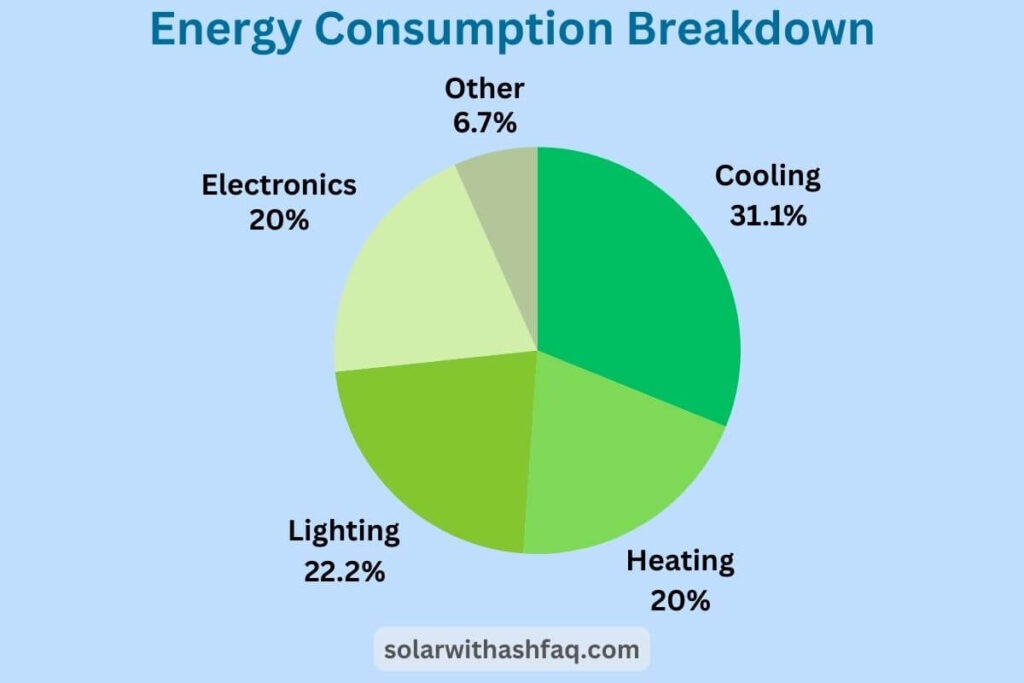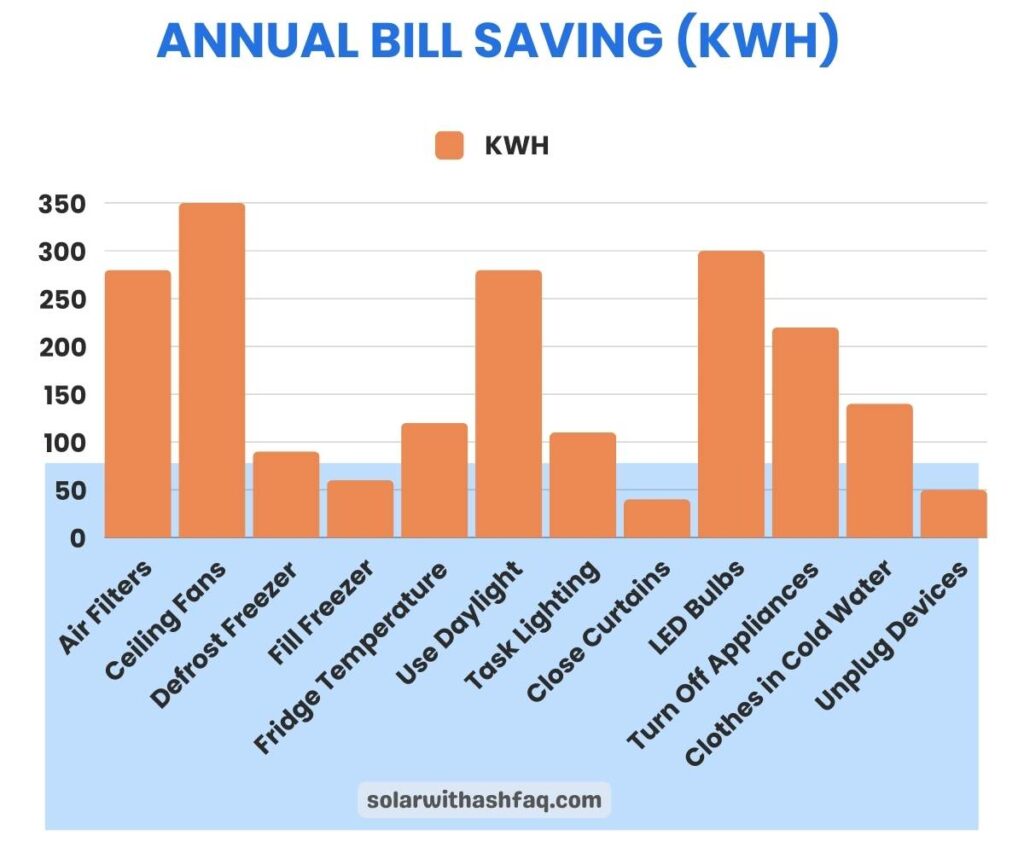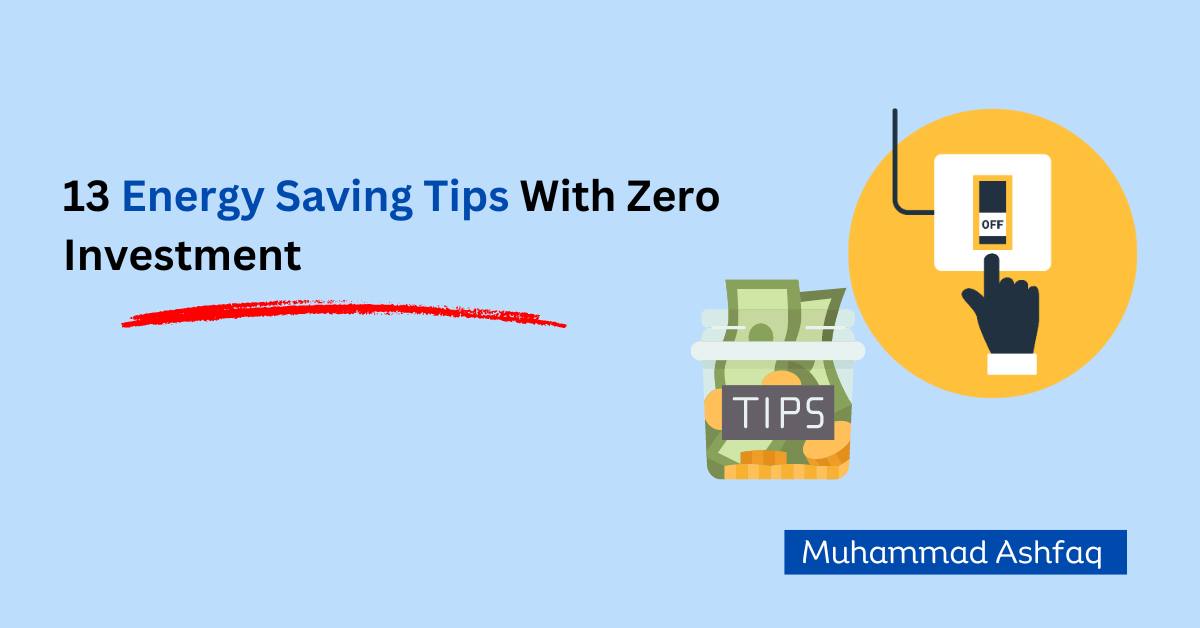13 Electricity Saving Tips With Zero Investment
Saving electricity doesn’t have to be complicated or expensive, I believe.
In fact, there are plenty of simple changes you can make around your home to reduce your energy bills noticeably.
And what’s even more interesting is that it requires zero investment.
So, are you ready to lower your electricity costs?
Let’s explore some practical, no-cost methods to start saving energy today.
Before that, it is important to identify where our energy is being used the most.
Breakdown of Energy Consumption in a Home
I acknowledge that each household has its own energy usage pattern. However, the everyday appliances used are generally the same.
And we can have a good overview of how homes use energy over the year.
Here is an overview:

Keep Your Air Filters of AC Clean for Optimal Efficiency
It’s a no-brainer: Clean filters allow for better airflow, reducing strain on the system.
When air filters are blocked, the AC consumes more energy to maintain the desired temperature.
Clean filters enable the system to operate more efficiently, which results in lower energy bills.
As a general rule:
- Disposable filters should be replaced every 1-3 months.
- Reusable filters should be cleaned every 1-2 months.
Pair Ceiling Fans with Your AC to Cut Cooling Cost
Using a ceiling fan lets you set your air conditioner to a slightly higher temperature without sacrificing comfort.
Because ceiling fans improve air distribution, ensuring that cool air from the AC is evenly spread throughout the room.
You can increase your thermostat setting by 2-4 degrees when using a ceiling fan.
The result? Energy savings without discomfort.
Close the Curtains to Keep the Heat or Cold Out
Closing curtains is a simple yet highly effective strategy to save on energy bills.
Closing curtains during the hottest part of the day helps block out sunlight, keeping your room cooler.
On the flip side, in colder months, closing curtains at night helps trap heat inside, preventing warm air from escaping.
There is another benefit of closed curtains beyond energy saving.
Heavy or thick curtains can help absorb sound, reducing noise pollution from the outside and creating a calmer indoor atmosphere.
Regularly Defrost Your Freezer to Save Energy
When ice builds up on the coils, it makes the freezer work harder to maintain the desired temperature.
This increased workload leads to higher energy consumption.
Defrosting ensures the coils are exposed, allowing the freezer to operate optimally and maintain the ideal temperature of 0°F (−18°C).
Also, overworking the freezer due to ice buildup leads to premature wear and tear on the compressor and other components.
Fill Your Freezer to Keep It Running Efficiently
This technique is my favorite.
When the freezer door is opened, a full freezer has less space for warm air to enter than an empty one.
This reduces the amount of energy needed to cool down the warm air.
Move frequently used items towards the front for easy access. This minimizes the time the door is open.
If you don’t have enough food to fill the freezer, use items like:
- Plastic bottles filled with water
- Crumpled newspaper
- Bags of ice or frozen water
Set Your Fridge Temperature Just Right for Maximum Savings
Setting your refrigerator and freezer to the right temperatures is essential for maximizing energy savings.
Between 35°F (1.7°C) and 38°F (3.3°C) is ideal for refrigerators.
The optimal point is around 37°F (2.8°C), which effectively slows bacterial growth and keeps food fresh without freezing items.
Also, allow hot food to cool to room temperature before placing it in the fridge. This helps the appliance work harder.
Maximize Daylight by Using Natural Light Whenever Possible
What is the alternative to nature, whether it is light or air? Of course, nothing.
Besides reducing energy costs, natural light is easier on the eyes than artificial lighting, reducing eye strain and headaches.
If you have a garden in your home, then trim overgrown trees and bushes outside to prevent them from blocking natural light from entering.
Popular Read: All You Need To Know About Solar Geysers
Use Task Lighting to Focus Light Where You Need It Most
Task lights, particularly LED options, consume less energy than traditional overhead lighting.
By focusing light only where needed, you can lower overall ambient lighting levels, leading to up to 26% energy savings in some office (or home) settings.
It also promotes better body posture.
Upgrade to LED Bulbs to Lower Your Bills
LED bulbs use at least 75% less energy than traditional incandescent bulbs. This means that for the same amount of light output, LEDs require far fewer watts.
In addition, LEDs can last up to 25,000 hours, which is about 25 times longer than incandescent bulbs.
So, invest a bit more while purchasing light bulbs, as it will benefit you in two ways: energy savings and longer life.
Turn Off Appliances When You’re Not Using Them
Appliances that are left on consume energy even when not actively in use. By turning them off, you can reduce your energy consumption and lower your utility bills.
Here is another angle: Many appliances generate heat when left on, which can increase cooling costs during warmer months. Turning them off helps keep your home cooler.
Wash Clothes in Cold Water to Save Energy
Heating water accounts for about 90% of the energy used in a laundry cycle. Washing in cold water can save up to 50% on your energy bills related to laundry.
Even you might have seen on many detergents that they work effectively in cold water.
As it provides excellent stain removal and cleaning power without the need for hot water.
Unplug Devices When They’re Not in Use to Stop Phantom Power
You know, many modern devices continue to draw power even when they are not actively in use.
Because they have passive elements like inductors or capacitors.
The energy they draw is referred to as Phantom power.
Laptops and adopters are the best examples of Phantom load.
Phantom power can account for 3-5% of your total energy consumption, leading to higher electricity bills without any benefit.
So have a check on them periodically.
Quick Overview of Annual Energy Saving
You might wonder what savings I can make by adopting all these small (but effective) tips.
Well, here are the annual savings of the electricity units (KWH) that will be reflected in your bills.

Last But Not Least: Use Less Power in Peak Hours
Some houses have installed three-phase meters from their utility company.
If you are from them, then you are already familiar with the fact that electricity used at peak hours is charged higher than off-peak.
So schedule high-energy tasks during off-peak times to take advantage of lower rates.
Check with your utility provider about off-peak hours and adjust your energy usage accordingly.
End Note
As a recap incorporating these zero-investment energy-saving tips into your daily routine can lower your electricity bills.
Remember! Every small effort counts, and these minor actions can lead to significant savings over time.
FAQs
-Use energy-efficient LED light bulbs instead of incandescent bulbs
-Unplug electronics and appliances when not in use to avoid phantom power consumption
-Use natural light during the day and turn off lights in empty rooms
Yes, using the auto mode on your AC can help save electricity. The auto mode automatically adjusts the fan speed to maintain the set temperature rather than running at a constant high speed.

Content Writer | Assistant Manager (Electrical) at IESCO
As a passionate content writer, I’m on a mission to make solar hassle-free for you through my expert guides and easy-to-digest content.

